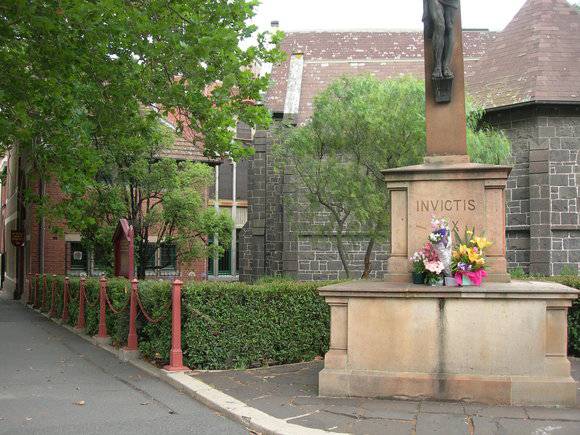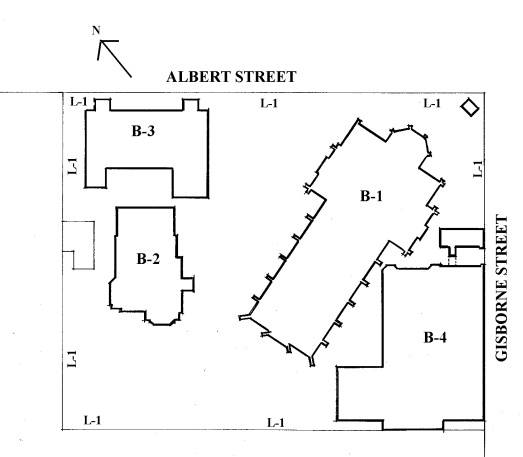| Back to search results » | Back to search page » |
|
ST PETERS EASTERN HILL PRECINCT
Location453-479 ALBERT STREET AND 13-19 GISBORNE STREET EAST MELBOURNE, MELBOURNE CITY
File NumberFOL/16/17005LevelRegistered |
|
Statement of Significance
What is significant?
The first Anglican services in East Melbourne were held in 1842 by
theRevd John Yelverton Wilson in a workshop at the eastern end of
LittleBourke Street. Charles Laing was appointed architect for a new
churchfollowing the submission of sketch proposals at the invitation of
theTrustees by five local architects. An initial proposal by
Sydneyarchitect Thomas Edmund Blacket did not proceed. The foundation
stonewas laid on 18 June 1846 by Charles Joseph La Trobe, Superintendent
ofthe Port Phillip District. The initial church constructed of brick
withstone facings had a shingled roof. It was formally opened on 6
August1848. The church was enlarged in 1854 to designs by architect
CharlesVickers with the nave increased in length, the transepts with
galleriesand a chancel added, and the shingles roof replaced with slate.
LeonardTerry carried out alterations including an enlarged chancel, an
addedvestry, and a Baptistery, with the new chancel opened on 29 June
1876.Work continued with five stained glass windows by Ferguson and
Urieadded to the chancel in December 1876. Repairs and alterations
werecarried out by Walter Butler of Butler and Inskip in 1897 which
includedinstallation of gas lines and Tobin tubes for ventilation,
removal ofthe transept galleries, and a new layout of pews to include a
centraland two side aisles. Further alterations took place during
1927-29including installation of timber panelling in the transepts and
chancel,and installation of a choir screen by Louis Williams. In 1945 a
stainedglass window was installed in the north transept designed by
NapierWaller to commemorate the New Guinea mission, and eleven
Anglicanmartyrs and to mark the centenary. A second Waller window in the
southtransept was subsequently added. The current organ is the third
organ inthe church and was constructed by George Fincham and Son Pty Ltd
andcompleted in March 1974.
Known originally as the Melbourne Diocesan School, St Peters School
wasopened on 11 April 1849. The original school, as well as the
sexton'shouse and parsonage were constructed in the late 1840's and
weredesigned by Charles Laing. By 1886 part of this site had
beentransferred to the Parliament of Victoria and the building
demolished. Anew vicarage and school were erected in 1886 to the designs
of WilliamPitt. St Peters Hall, designed by Alexander North was erected
in 1913 aspart of St Peters School and contained a large hall and 2
classrooms.The school suffered economic difficulties during the
Depression and wasclosed at the end of 1935. Since that time the hall
has been mainly usedby theatrical and music groups.
How is it significant?
St Peters Eastern Hill Precinct is of historical, architectural,
andsocial significance to the State of Victoria.
Why is it significant?
St Peters Church is of historical significance as the oldest
Anglicanchurch in Victoria on its original site and as the focus of
Tractarianor Anglo Catholic tradition in Victoria. The tradition is one
of fullliturgical practice combined with an active interest in social
justiceissues and was particularly promoted by Canon Ernest Selwyn
Hughes(Vicar 1900-1926), one of
the greatest pioneers of Catholic Revival in Australia. St Peters
Churchalso has an historical association with the granting of
Melbourne'sstatus as a city, with the letters patent of Queen Victoria
having beenread in St Peters on 13 February 1848. St Peters is of
historical andsocial significance for its association with the Revd
Canon FarnhamMaynard (Vicar 1926-1964), vicar during the Great
Depression whoinitiated the introduction of the Brotherhood of St
Laurence intoVictoria with its development of social work programmes and
fostering ofawareness in Melbourne of social justice issues. Revd
Farnham Maynardwas also responsible for the installation of the transept
windows byNapier Waller. The New Guinea windows in the north transept
are ofhistorical significance for the representation of the eleven
Anglican martyrs
and the south transept windows for their anti-war theme. St Peters
Hallhas continued associations with the musical life of Melbourne.
St Peters Eastern Hill precinct is of architectural significance for
itsassociation with a successive number of prominent Melbourne
architectswho contributed to the development of the church precinct:
CharlesLaing, CharlesVickers, Leonard Terry, William Pitt, Walter
Butler, LouisWilliams, and Alexander North. The group of buildings forms
apicturesque precinct. The vicarage and school are early examples
ofWilliam Pitt's work and are substantially intact. St Peters Hall is
thefirst work in Victoria of Tasmanian emigre architect Alexander North
whospecialised in church architecture.
Group
Education
Category
Other - Education









